Hi all,
I am spinning this out of a previous thread which I was starting to take over. Apologies to Brotaniker! That thread is here:
https://www.thefreshloaf.com/node/68848/baguette-dough-how-long-can-stay-it-fridge#comment-492835
We happened to want to embark on the exact same experiment, to the point that I saw his post after having started the bulk on my batch.
The aim - for me - was to determine the result of different lengths of cold retard. Anticipating some time not so far away when I am back at work full time, I have been trying to develop baking schedules that give me the maximum out of the timing I can accomodate, with the goal of having fresh bread ready for lunch on a Saturday/Sunday.
For 'baguettes' (demi-baguettes, long batards - whatever!) that means autolyse, mix and develop at night, then bulk until bed time and leave until some following morning. I have found that taking the dough out around 7am sets me up fairly well for bread to be cooled and ready by 12:30-1pm.
In the end, I want to be able to make a 4-loaf batch and during the week and bake half on Saturday morning and half on Sunday morning, with the Saturday bake having enough time to mature without the Sunday bake being pushed to far. I think the 32h/56h times are going to be the winners here but if there is a geniune improvement at 56h and the 80hr is not too far gone then starting one day earlier is no extra work.
Timings for the cold retard are thus:
- 1 night: 8hr
- 2 nights: 32hr
- 3 nights: 56hr
- 4 nights: 80hr
For this test, I made a standard ~900g batch @ 75% hydration and started with the 32 hour retard so rounds 2 and 3 will be at 56h and 80h respectively.
All batches at going to come to room temp in the morning for an hour or so, get a pre-shape, proof for another 1.5 hours, then final shape and ~1hr fianl proof.
Bake 1 - 32hr cold ferment.
Taste: very good
Crumb: great
Crust: thin and crispy



Bake 2 - 56hr cold ferment.
Taste: very good - difficult to discrern much (if any) difference from the 32h bake. Perhaps a little more flavourful - my partner didn't want any until I requested help judging the outcome. The immediate follow-up: "if you have more, I wouldn't say 'no'."
Crumb: great, again. To me it was a little chewier, though that may have been down to the extra difficulty I had with shaping this one (see below) - you can see a denser spot in the top-down photo, below, that is nearly certainly due to shaping/handling issues. The verdict from my ever-reliable assistant was that it was slightly better and 'lighter'. Not sure I found it lighter but it certainly wasn't heavier or denser (shaping notwithstanding!).
Crust: thin and crispy, again, and nothing at all to complain about. The mandatory slight squeeze as I transferred it to the cooling rack brought forth the sought-for crackle. After a second (and sadly final) testing, the verdict was in: my partner is certain that this crust is better. "Easier to eat, too." Apparently.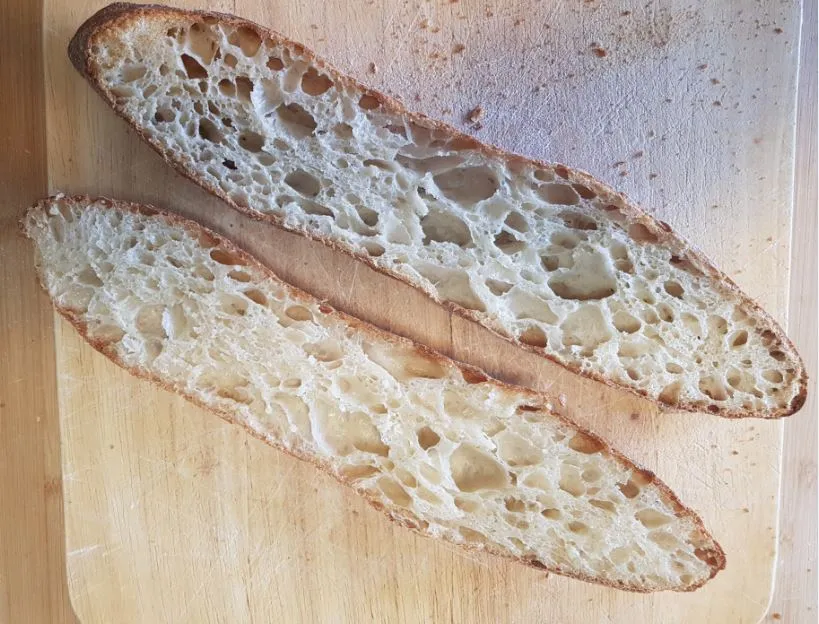
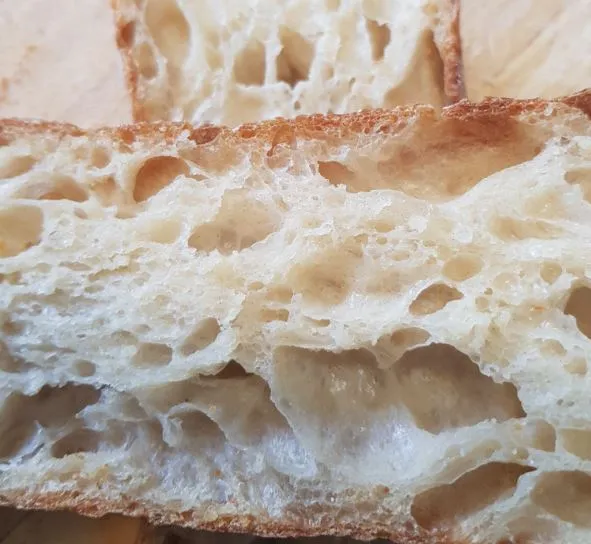

Please excuse the poor shots - I am no photographer. For the detailed view, I deliberately chose a section with a denser-than average crumb and for the cross-section, I played with the colour temperature and brightness a little to show the gelatinisation, which I felt to be a little more pronounced in this bake than the last (though my other shots don't really show that!) Here's another shot of the cross-section which better shows the crust:
Bake 3 - 80hr cold ferment.
Taste: good; not great. Better than a single day straight dough but it didn't seem in any way better or more nuanced than the previous bake. Potentially a backwards step.
Crumb: average at best and chewier than the last baguette but this time having gone too far in that direction. That could have been due to the greater difficulty in handling and shaping and/or the degradation of the dough itself.
Crust: thin and crispy, again and still good but - I felt - not as good. That said, it was stil thin and it was still crispy so perhaps it was not the crust at fault but the firmer, chewier texture, which resulting in having to tear at the baguette a little more when trying to secure a bite.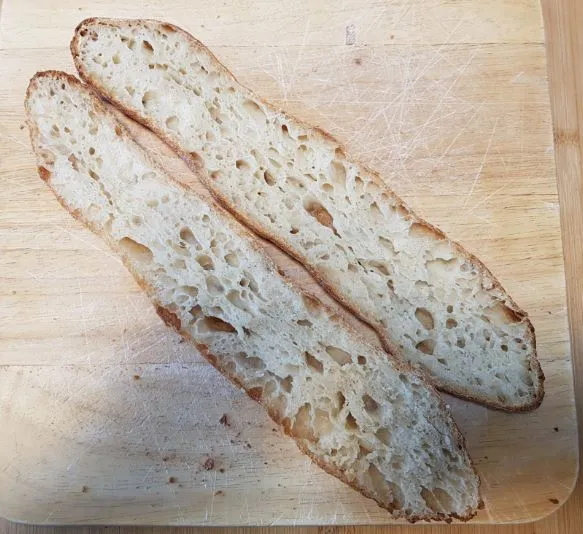


Conclusion
As expected, the 32h and 56h cold retards were beneficial, with the 56 producing a slightly chewier but yet lighter crumb and the 80h was just too far and the dough had clearly tipped over into being past its best. A more competent baker could no doubt have made a better baguette from it and mitigated the problems I saw. The proof is in the eating, however, and there was no benefit in taste for the extra time.
d
For specifics, this is my process:
Formulation:
Flour (T65 @ 11.5%) - 100%
Water - 75%
Salt - 1.8%
Yeast (IDY) - 0.4%
---------------------------------------
1. Autolyse
500g flour (11.5% protein)
325g water
- 2 hours (I meant for 1 hr but work called!)
2. Add yeast
2g IDY dissolved in
30g water
- dimple and pinch/folder/scrunch in.
- leave to absorbe for 15 mins.
3. Add salt
9g salt dissolved in
20g water
- dimple and pinch/folder/scrunch in.
- leave to absorbe for 15 mins.
4. Slap and fold
- 20 mins.
5. Rest
- 5 mins.
6. Gentle 'slap' and folds
- 2 mins, just to bring back together, rounding up.
- placed into container.
7. Fermentation start
- 1 hour.
8. Stretch and fold
- gentle 4-way stretch and fold.
9. Ferment
- 1 hour.
10. Stretch and fold
- gentle 4-way stretch and fold.
11. Ferment
- 4 hours at room temp (~15c ambient).
12. Retard/cold ferment
- Started, dough temperature 19.5c.
Nothing special but that's specifically so I can see how this flour tastes without adding in rye flour and some sourdough starter, as I did recently with my normal flour.
I will let you know how I go!
d
UPDATE - next morning
The dough was visibly more developed - a little large and with more bubble showing. Dough temp was 5.5c, which seems high, I'll admit but woke up a few times through the night and checked the dough and it seems the fridge door was slightly ajar for around 2 hours overnight!
Seeing as the dough droped 1c per hour last night on the bench I suspect it will be down to 4c before overly long this morning.
UPDATE 2 - mid-morning
Measuring after ~2 more hours, it's at 4c exactly. I would say it's mostly doubled but. When I start tomorrow morning, I'll remove 1/3rd (~220g) and leave that to come to temp before pre-shaping and see how it develops from there.
UPDATE 3 - bake one (~32h cool ferment/retard)
Baked and cooling. Pre and post-shape proofing was a bit haphazzard due to unfortunate timing of some urgent work issues and shaping was a little rushed as a result but, again, that's not super important to me for this as it's a taste test and a dense, ugly loaf should serve as well for that purpose.
Cut, served, eaten. (There are some few small consolations during lockdown and being able to put a freshly baked bread on the table for lunch is one of them.)
UPDATE 4 - bake two (~56h cool ferment/retard)
This portion is now resting after being brought back to temp and pre-shaped. From the start, I noticed that the dough was more extensible and seemed either more fermented (airier) or simply more degraded (looser) - it's hard to know which. This was straight from the fridge as the remaining dough had spread out to the same footprint as the original mass, despite now being 2/3 the quantity. It was also 'stringier', with more strands when I lifted one side of it up to cut off the next piece. And, after bringing it to temp it did seem softer and airier than yesterday.
I might bake this one a little earlier today as it does seem further along. Previous temp checks show that a dough left overnight in my fridge will be at 4c in the morning (as this one was after the first overnight retard) so there's no particular reason to expect any more real yeast or bacterial activity, however the enzymes should still be going at it pretty much right down to 0c. I don't have any way to measure pH (sorry Benny - I'll get there!) but I would assume something relatively safe, like 5 (IDY, not sourdough!). So, on temp and pH, amylase activity should be down to about, say 15% of 'normal' (assuming a just-mixed dough is ~25c and pH of 6).
On this evidence, I am expecting a more challengin shaping tomorrow and perhaps a degraded result but I always figured 80h would be pushing it unless you can get the retard down closer to 0c. Time, again, will tell.
Baguette #2 is now in the oven. It seemed okay in the couche but, while I was more measured in my scoring this time, it was more difficult - even with a wet blade - and it seems to have spread a little more in the oven. Definitely not expecting anything even approaching an ear this time. (Not that I was last time, either!)
UPDATE 5 - bake two (~56h cool ferment/retard)
Baguette number two has now been cooled, sliced and (mostly) consumed.
Definitely felt different when I put it in and it didn't respond quite the same. How much of that is due to insufficient practice to ensure consistency is an open question. More details as appropriate above and below!
UPDATE 6 - bake three (~80h cool ferment/retard)
In short: not worth it.
Edible, to be sure and tasty enough but not more so than the previous two and perhaps just slightly less so. Certainly less enjoyable, over all as, while the crust was still nice and crispy, the crumb was noticeably denser and chewier, but a bit too much so.
The dough was noticeably stretchier but, again, not really in a good way, and the shaping was miserable, as was the scoring.
Sliced and toasted it was quite good but needing to toast a fresh baguette to get the most out of it is perhaps not a ringing endorsement. Photos and details above and below, as before.
d
First one has a lovely irregular crumb with finger tip sized alveoli Dan, nice. Post photos of the outside as well, it is always good to see if the extra cold retard time has had an effect on the crust and ears.
Benny
Thanks Benny.
Unfortunately, my shaping was haphazard and my scoring was rushed ("I'll call you right back in a minute!") and is not the best even when I have plenty of time so I'm not sure what can be inferred beyond that I clearly need either more practice! (Which is why I decided not to add this image earlier - I doesn't reflect the bread so much as the baker!)
Bake 1 - 32hr cold
Image

Image

Bake 2 - 56hr cold
Probably even less definition on this one. While I have not a fraction of the skill and experience (this being only my 4th batch of baguettes,) to be consistent enough to draw any real conclusions, the dough was noticeably different to work with - even straight out of the fridge, removing the portion for this bake.
Bake 3 - 80hr cold
Image

I think that sorry image tells the story. The dough was different again and, this time, it did indeed feel past it. Of course, I expect a more competent baker to have been able to manage but I don't see the point it bothering - it would have been making the best out of something past its prime, which is a valuable skill to be sure, but there's no good reason to do this intentionally.
The main reason I'm asking is because it was really apparent to me during the Baguette CB last year that I can get incredible open crumb at the expense of great ears or vice versa. So it would be nice to see the effect of your extra cold retard on ears/grigne. Now if the dough was sourdough instead of IDY I think that effect would be even more pronounced, but I'm still very infestered in what you find.
Benny
Your crumb looks exceptional.
What I've found is that I can mostly get really great scores, but almost never approach the types of open crumb that you and Benny achieve. As Benny can most often get both, it is, of course, doable. And as I've mentioned on TFL a handful of times before "the first 10,000 are the hardest", after that it becomes easy.
Thank you mate.
Honestly, I don't much mind the lack of a ear/gringe or the mishappen form - the structure, texture and, of course, taste are everything to me.
I did utterly fail at anything approaching an open crumb on one very rushed, poorly shaped and likely under-proofed batch a week ago but the interesting thing was that they tasted fantastic all the same. They were quite dense and I thought - at first bite - they were a little flavourless, however when I cut the second one up the next day I devoured it - I just kept going back. Each time I would take a deep breath, inhaling the aroma and exclaiming, with something approaching disbelief: "it's just so sweet".
Perhaps it was actually the under-proofing that helped there as it may have been that there were residual sugars that would otherwise have been fermented had it proofed correctly. Not sure but it was a unique loaf - a dense, sweet and yet still crusty baguette. Actually, I would rather like another slice or three of that one right now!
Having both the looks on the outside would be nice but I've managed well enough without so I can hardly ask more of my breads.
That is what I was expecting with further fermentation, less definition on the outside, but likely even more open crumb.
Benny
I think you meant 1.9%
The crumb is very nice, will be waiting for the next test. I would like to have dough proofed in the fridge and bake it when needed over the next 3 or 4 days
Good pickup! Actually, 9 grams - in this case 1.8% (my starting point). Now corrected.
I am also eagerly awaiting the next test!
I am fairly sure a 56-hour retard will show no issues whatsoever - the real question is: will it be better?
And to confirm, yes, the crumb was as good as it looks - just the right amount of chewiness and a good flavour for a simple, straight dough.
T 65? I have just ordered 22# from L’Epicerie. Will let you know how it goes! I had forgotten about them and I remembered they have great reviews. c
Thank you for starting this thread
I can't say that French flour is, specifically better. What I was looking for was some flour a little less white than our plain flour but not wholemeal. At the time, I was actually looking for some Italian tipo 1 to add to some pizza dough.
How French flour responds, in terms of hydration level, mixing requirements, fermentation tolerance, temperature range and so on are somewhat lost to me. Once I've completed this test (or perhaps before!) I'll repeat with my 'normal' flour and again with some bog-standard off-the-shelf plain flour - to see how they compare when trying to keep everything else as similar as possible. Maybe one is bland at 32 hours but perfect at 56h and maybe another doesn't last that long at all and becomes problematic. Time will tell.
To me, I think that the important part, generally, for baguettes, is that you don't use overly strong flour. The flours I have to hand for this purpose are:
I realise all those numbers are a little low by US standards but that's what we have. I suspect that there is a secondary factor in all these, which is that the starch damage is likely a little lower in the above, compared to US flours. Starch damage occurs as a natural part of breaking up the wheat berry but the simple fact is that higher-protein wheat = harder berries and the harder a berry is, the more force must be applied to break it down, with the result of higher starch damage.
How that factors into a baguette I cannot say but, as with everything in baking, it's all a complex 'dance'. When we, as enthusiasts (and amateurs and professionals,) think in wonder of the myriad different end results that can be obtained from those four simple ingredients, it's exactly this interrelated complexity that allows it so, in a way, everything matters!
But that is not to say that one way with one set of ingredients is better as methods and materials are inter-twined and it is simply that certain methods have evolved to deal with the peculiarities of the available ingredients and, over time, what may have been seen as a deficiency, becomes a key factor but only because the method assumes it!
At any rate, portion 2 has been revived and pre-shaped.
d.
Caroline, I can tell you that Dan, Geremy and Don all love that flour for their baguettes. They all loved how it handled, the thin crisp crust and the flavour which they all said was so much better for a baguette than any other flour they had used for baguettes. They all claimed that there was just something special about that flour for baguettes.
Yes there are so many variables in bread baking. I always go into it with the idea of letting the ingredients tell me what they want. I have baked all our bread since the 70's so I have had a lot of instruction from the flours !! I will look forward to trying something new. The flour was ordered this afternoon and will be here Friday !! So baggies on the weekend I hope . Will let you know how it goes. c
Well, at 20lb, you'll certainly have a bit to keep you going and ample room for experimentation. I think I am going to start a new batch tonight with our off-the-shelf plain flour. The bag I have shows 10.9% protein, which is actually on the high side for us here but inside the range for what I imagine to be optimal strength for a baguette dough.
The timing will work well - if all goes to plan (ha!) I will be eating baguette #2 of batch A today, #3 of batch A tomorrow and then, the following day, baguette #1 of batch B should be at the 32h proof stage and ready to bake.
Perhaps I will even then overlap, following that, with my 11.5% 'bread' flour. Nine days of fresh baguettes? However will we cope? Just as well we have a decent selection of cheese and some nice cultured butter hanging about - else it might get tiring : )
(I know a lot of people are doing it very tough at the moment and, while we are not operating anywhere close to normal income in our house, we are taking the benefits of our forced isolation and reduced occupation where we can and the simple pleasure of a nice home-baked baguette is not the smallest of those.)
Best of luck with your own experiments - I shall be looking for the outcomes but if you would be so kind as to post an update with a link in this thread when you have news, that would be appreciated!
d.
cultured butter and cheese !! How unfair !! When we rode our bicycles across France in 2014 we stuffed ourselves daily !! We started in May in Vienna and rode to Nantes arriving on Bastille Day. What an adventure and will not soon forget the lovely people, food and views. We ate so much and drank so much good wine the only thing that saved us was cycling every day carrying all we needed to camp and or stay in gites.
I shall definitely post back. Thanks again. c
Hey Dan - how did you stay sane during one of the strictest and longest lockdowns?*
Stay what, now?
Image

Image

* Sorry to my Victorian brothers and sisters - I am still a Mexican at heart, despite my many years away.
I remembered after I posted the inquiry about the t65. I will review that CB before starting. I’m a hands off baker as much as possible so simple is better . I figure we will have 11 one # batches lol!! So by Christmas I’ll need more 🤦♀️😂
You’re welcome Caroline, there is the summary document that was created to try to summarize the CB into a readable thing rather than the extremely long post that it is. I look forward to your baguettes baked with that apparently awesome flour. I wish I could get my hands on it but I’ve never seen French T65 in Toronto.
L’Epicerie is shipping from the East coast not Europe. They obviously have distributors set up all around. Contact them I bet they have a distributor in Canada . The shipping I chose was cheapest and still 2 day! It brings flour to $3 a pound. Not too bad at all considering what some Mills like Barton Springs is charging. Hope it works for you. c
Thank you Caroline, I’ve just sent them an email. With all the compliments that that particular flour has received around here, I’d like to try it to at least compare it to the flours I have easy access to here in Canada.
Benny
Hoping it works out!! C
Flour got here Friday! Great shipping speed and packaging . Beautiful flour! Looking forward to lots of experiments. It shipped from NJ USA
They have not replied at all. I’ll send them another email at the end of this week if I don’t hear back from them.
Benny
And see what happens as far as shipping charges. Just empty cart and back out after get you info. c
And see what happens as far as shipping charges. Just empty cart and back out after get you info. c
And see what happens as far as shipping charges. Just empty cart and back out after get you info. c
The shipping is over 60 USD!! A bit too rich for my blood.
That’s crazy. Maybe one of your Toronto French bakeries will sell you some? I used to get my “00” flour at cost from a pizzeria in Atlanta years ago. It felt very much like this T 65 dies as a matter of fact. Anyway maybe call around and see. c
Small update as I have now repeated the experiment with standard home-brand plain flour from the supermarket (10.9% protein).
The recipe and process was essentially identical, though I did hold back some of the water and ended up dropping the hydration a few percentage points as the flour felt wetter than the last batch. In the end it was okay and probably could have taken the full measure but it was fine as it was.
I also made quicker work of my slaps and folds and, as per recommendations, let the dough rest for 5 minutes in the middle.
The other change was that, instead of the 32h/56h/80h split, I brought it all forward a day, ending with 8h/32h/56h.
The findings were exactly as expected: the 8h cold-retard dough was good but the flavour was not quite there, while the 32h and 56h were noticeably better in all ways.
For Benny (though I know he's more interested in the eventual SD version of this!) here are the crust shots of the 32h and 56h bakes.
32h cold retard
Image

Image

56h cold retard
The 8h one is no use to anyone as I rolled it out too long and had to literally squeeze it back together, such that the only thing that can be inferred from that loaf is my lack of practice!
In terms of crumb, they were close enough to identical to be accounted for within standard margin of error.
My starter is seemingly a little haphazard at the moment but then I've never been one for too much consistency with it. While I wait for it, I am going to do another 'test' (read: "I like eating baguettes") using the same, plain supermarket flour but with a little added diastic malt. Seems a good enough use of my time and stomach while I await my starter.
d.
You sure are getting a ton of practice shaping baguettes, which is great. I love the pointy tips you’re getting. Assuming you’re able to shape and score reasonably similarly, I know I still do not, those two baguettes do show a slight reduction in the grigne/ears with further cold retard. Extra warmer proofing certainly shows the effects of improving openness of the crumb and reduction in grigne/ears more than cold retard.
Both are good looking baguettes Dan.
Benny
Yes - your assessment is spot on: a small but noticeable reduction.
The shaping was fairly consistent on them as, after the failure of the first bake I was able to close in on better pre-shape dimensions for the size of dough and available pizza stone real estate.
Here are the two bakes (i.e. 32h and 56h) for comparison. A little difference in the crumb - the second loaf had more openess, but this is accentuated by my cutting, which showed through more of the crust, exaggerating the effect.
Image
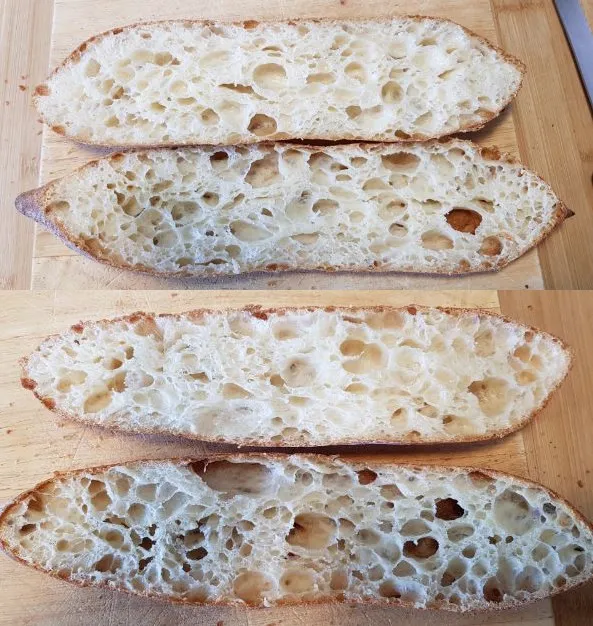
Thanks for the kind words - I have one more batch to do (plain, supermarket flour + diastic malt) but I missed my window for tonight so I'll start that off tomorrow.
Once my starter is ready, I think I'll try for the following schedule (again, looking for something I can replicate during the work week to have fresh baguettes on a Saturday and Sunday):
DAY 1
-----------------
21:00 - Autolyse
22:00 - Mix in starter and then leave for 15 mins
22:15 - Mix in salt and leave for 15 mins
22:30 - Turn out and slap+fold (10m with 5m rest)
23:30 - Fold then leave overnight
DAY 2
-----------------
06:00 - Place in fridge
DAY 3
-----------------
08:00 - Take out, bringing to temp and follow normal morning procedure
That would give a warm bulk time (i.e. from addition of the starter) of 8 hours, with a cold retard of 22 hours.
I think an innoculation of ~6-7% should be about right to get my bearings.
Thanks for you continued input and encouragement.
d.
I've never let a retard go for more than perhaps 24 hours, so it is refreshing to see these comparisons.
Your baguette crumb is quite noteworthy, and approaching Benny grandeur. They look good and shaping and scoring will continue to improve over time, perhaps a short time with concentrated effort.
Alan
Too kind.
Let us not forget, however, that I am baking these with commercial yeast and Benny is turning out his tour de force bakes with sourdough - a far more temperamental and demaning beast, as we all know!
d.
with commercial yeast as wells levain based dough. Once you get a levain/sourdough culture mature and a little practice, it is really no different than using commercial yeast in terms of complexity or skill.
There is evidence all over TFL and elsewhere of the success of the Bouabsa IDY baguette. The one that put me on the board when I first undertook making these batons. Don D's IDY, the Gosselin IDY baguettes, Martin Phillip's & Jeffery Hamelman's also quickly come to mind. There is a fat smattering of them on TFL to admire and attempt giving a try if you aren't quite ready to take the levain journey.
There's plenty of room for both in anyone's formula/recipe book.
added edit. Re: your baguette profile picture below. If you haven't made a few ugly baguettes, then you haven't been baking them long enough!
Wow stunning crumb, so open and beautiful. The lower of the two, I think 56 hr is slightly more open, but both are gorgeous.
Benny
The more I look at it, the more I'm inclined to agree as I notice that the crumb is better right to the edges, where the first one is a little more closed around the outside.
Thanks again - if I can get close to this with a sourdough that will be quite something but the goal for this particular experiment was always to figure a reliable, workable method and schedule so I have something to fall back on!
d
My flour arrived Friday! No time yet to use it. What shaping method are you using? I’m looking forward to trying it out in the next week . Will definitely be referring back to this posting. thank you! c
Thanks.
I would caution you not to imitate me as my result are . . . not always as desired. Por ejemplo:
Image

This is what happens when you focus on how your rolling feels and looks, rather than how long you have made it. The result: me trying to squish it back down to size, failing and impacting the crust and crumb (but adding a cute nose).
My 'baguettes' are, of course, nothing of the sort and, aren't even a scaled-down version as I use around 280g of dough for a ~36cm long 'demi-baguette' as that's what I can fit.
As for shaping, I (now) pre-shape to a squarer rectangle (probably about 1/3rd the final length) and then final shape by folding that over and then simply rolling. I figure the less handling the better and I tend to go for 1-1.5hr from final shape to bake so don't want to mistreat it too much.
I don't follow any technique or guide - I have just kind of experimented until, with just the last two, I am somewhere I am happy enough with as a good place to tweak from.
Best of luck - I look forward to the results!
I always like less is more in all things… particularly those I’m not great at 😂. I let autolyse and my KA mixer do all the hand work. I believe in the CB that baguettes made with yeast and time were reviewed as being tastier so I’m going for the yeast versions. Temperamental I don’t need( knead). Thank you. c
Caroline, I didn’t find that the yeast only version of baguettes were tastier. Give a hybrid one a try first and see what you think of the added flavour contributed by the LAB from the levain but have the back up of the IDY. My first successful sourdough one was intended to be a hybrid in which I forgot to add the IDY and found that I could actually make a sourdough baguette successfully.
Exactly this.
My own path there - documenting my first and second batch of baguettes is here:
https://www.thefreshloaf.com/node/68721/baguette-long-bulk-vs-poolish
Certainly the little bit of rye added a lovely colour, too. Here is the result of that - action shot, so to speak:
Image

d.
The tastiest ones I made were from my second (ever) batch and I added 10% light rye flour and some relatively mature starter but it was still primarily with commercial yeast.
That said, maximum flavour with minimum fuss with a workable schedule is the goal.
I now have a sourdough in the fridge for a 24hr cold retard. Unfortunately, I overshot the overnight ferment. All was good and I had it timed so that my yeast dough (with addition of diastic malt) batch was coming out of the fridge at the same time the sourdough batch was going in . . . I just forgot to do the second part!
So, overshot by ~2 hours, which is not great but we'll see - it was only a guess at timing anyway. It's pretty much exactly doubled so that's definitely further than I wanted, given it will take time to get down to 4c.
We'll see!
UPDATE - bake 1
So, I decided to bake a loaf of each this morning as the SD one did look doubled.
The plain flour + diastic (0.5%) had had 4 hours RT bulk then ~7h cold retard and the usual morning routine following. The SD had about 10 hours bulk and I put it in the fridge (belatedly) but, after a quick internal monologue, decided to take it out again, give it 15 mins in a warm room to come back to temp, after which I followed the same (by now standard) process as the plain dough.
Baked the plain one first then let the oven come back to temp for 30 mins, which more-or-less equalised the bench/pre-shape/shape timings for both.
Unfortunately, I shaped the SD a little shorter and that seemed to impact the crumb, though it was a bit gummy, too. Not really sure if it's over or underproofed. Neither would surprise me!
For the plain + diastic, I didn't really notice a great deal of difference in taste, though it did seem just slightly more relaxed in handling and the crust did seem thicker - not enjoyable as previous bakes. The test here was to see if the addition of some diastic malt might effectively accelerate the process, allowing a better overnight baguette but it seems that, while the 7-8h retard is better than nothing and does seem to improve the crumb, it's not enough to turn a plain baguette into something special.
Beyond the not-quite-right structure of the SD baguette, the flavour did have a noticeable sourdough flavour, which was good, but didn't have the same sweetish taste of the longer-retarded normal yeast doughs. The test will be tomorrow, of course, as that extra 24 hours in the first really does seem to turn them from 'acceptable with cheese' into something that gets half-devoured before you've even left the kitchen.
Apologies for the delay - Internet outage.
In each, the yeast + diastic is the top; the sourdough (no diastic) is the bottom:
Image

Image
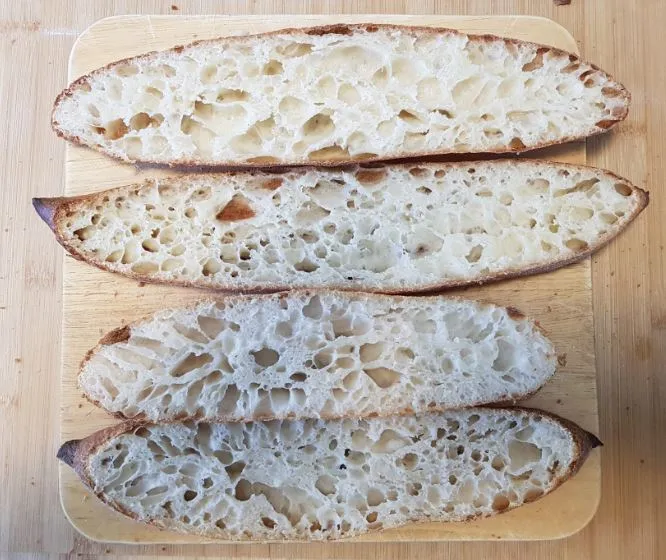
Image
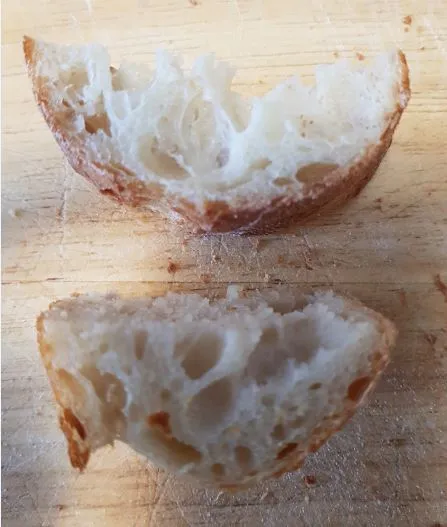
d
UPDATE - Bake 2
So, this is second loaves of each of the two doughs. (Again, one yeasted with diastic malt and one SD with no diastic.)
Yeasted + diastic
The yeasted is pretty much as expected - an all-around improvement over the 8h cold retarded dough but, as found yesterday with that bake, the crust was darker than the previous experiment with no diastic malt. It was also thicker than the one baked without diastic malt however, as per expectations for the increased cold retard time, it was crispier and somehow lighter than the 8h, despite not being thinner. Perhaps not exactly what I might consider ideal for this type of bread but very satisfying and enjoyable.
This nearly confirms the hypothesis and previous tentative conclusions that an 8h retard is just not enough for this recipe and schedule and, despite its exotic over hear, diastic malt is not magical pixie dust.
Sourdough (no diastic)
The taste and the crust was better than yesterday but the crumb was as uninspiring. I believe over-proofing is at play at those accidental extra 2 hours on the bench yesterday morning took it too far. Of note, oven spring was very irregular and significantly less, overall than expected (or at least than hoped). In shaping, it was actually a slightly more uniform and pleasing than the yeast dough and I even got it into the oven straighter.
Doesn't mean I haven't eaten half of it already, of course as, again, the flavour is good.
As before, the yeast is on top and the SD below.
Image

Image

Image
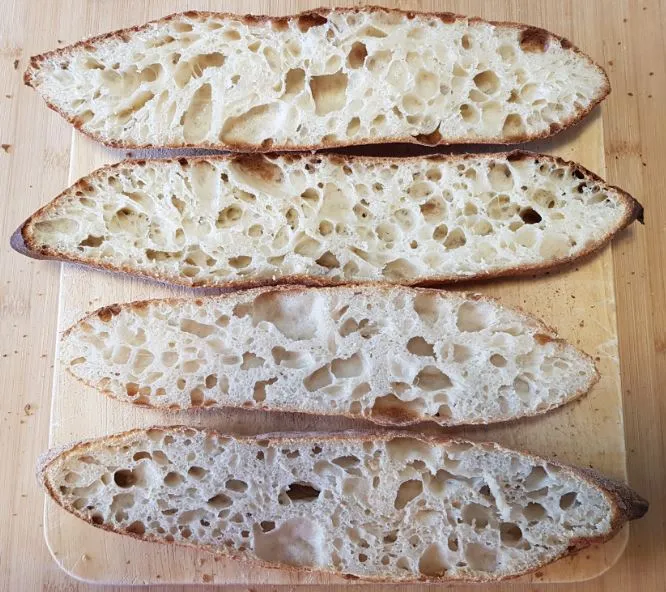
Image

Despite everything else wrong with it, here you can clearly see the thinner crust on the sourdough (bottom) vs the diastic-'enhanced' yeast (top). All signs currently point to that being due to the diastic malt as previous bakes did not show this. Perhaps 0.5% is simply too much when you are already retarding for 24h+.
What I find most interesting is the wavy edges of the expansion cracks (let's not go calling them 'ears'!). It's interesting because the scoring was done in single, straight and fairly confident motions and I made no further deepening incisions. I actually thought the scoring - particularly on the SD - was better than yesterday's loaves.
Perhaps this is an indication of what's going on with the reduction in prominence of the 'ears' as the dough is left longer. It almost seems as though the dough just kind of meandered its way outwards rather than 'sprining'. Which, I suppose makes sense as, even at 4c, activity does continue and there is likely less power in reserve and less strength to hold it as well.
Maybe.
d.
Interesting findings Dan. I add diastatic malt in order to help the browning of the crust for my baguettes. Because of their relatively short bake time, I find that it can be a challenge to get a good browning of the crust in such a short time. Although I would only add 0.5% to my hearth loaves for baguettes, yeasted or sourdough, or hybrid for that matter, I add 1%. It is interesting that you found that the yeasted baguette had a thicker crust, if anything I have found that the yeasted ones I’ve made have a slightly thinner crust than the sourdough ones, however, I have never baked them back to back to have them side by side to compare as you did. For the yeasted baguettes I have certainly had them at 3ºC for well over 24 hours without any deterioration of the dough. Actually the same goes for the sourdough baguettes as well.
The crumb you have achieved for the yeasted baguettes is beautiful, so open, love it. Perhaps there was a bit of over fermentation particularly in the sourdough one as evidenced by the lack of ears in the longer cold retarded one. The thing that surprises me is that typically when I have over fermented a bit with my baguettes I get an even more open crumb with fewer areas of density in the crumb and then no ears.
Benny
So far, what I have come away with is:
1. The cold retard definitely helps given my schedule, flour, process and technical ability. The difference, when taken as a whole, between the overnight (~8h) retard and the following day (~32h) turns an acceptable baguette into a good one. At least so far as my preferences are concerned.
2. The additional 24hr is also an improvement but, as is to be expected, it's a case of diminshing returns. HOWEVER, if the goal is to be able to make 1 dough and get two days of baguettes out of it, the additional day is fine - better in some ways but marginally worse in others - again, depending on preference.
3. Another night is not really agreeable but doable, with good technique.
4. With my oven and my flour and all the other parts that combine for me, the diastic malt doesn't really help things much, if at all. This, however, is where I have the least experience so perhaps 0.25% or 0.1% might boost things enough to give me an nicer crust than I get without, but it'd be marginal and not, I think, worth the effort of finely weighing another ingredient.
5. The sourdough (again, in my case) produces a more complex flavour that, with minimal (overnight) retard, is just better than the plain, yeasted dough. With an additional day of retardation, it's not objectively better anymore and simply a matter of preference.
6. The T65 flour is, at all stages, tastier than the plain flour but, like the sourdough, the plain flour makes up some ground with as time is increased. The T65 may perhaps be technically better but so far as the contribution of the structure to overall enjoyment of the finished product is concerned, if there is an improvement, it too small to be consistently brought out by these amateur hands!
And yes, I definitely feel that the sourdough was over-fermented. But then that is hardly a revelation, given I absent-mindedly left it on the bench for ~25% longer than intended!
Thank you for your continued kind words and encouragement. My results with the sourdough push me towards trying to nail down a workable schedule for it, however my previous experience adding some moderately mature (but fridge-cold) sourdough to a yeast dough that was already enriched with a little light rye shows that, with adequate retardation, it should be possible to reach the best of all possible worlds.
That's probably where my main efforts will be focussed in future testing:
Thanks again - one more bake to go!
d.
UPDATE - bake 3 (56h retard)
For those keeping score, this is the third and final bake of the third and final batch (which itself included two doughs for expedience and comparison).
Everything was pretty much as expected with a few exceptions:
What was the same of as expected?
So, the big take-away was that, at this 56h mark, the flavour of the yeasted + diastic baguette was noticeably sweeter than the 32h version. This being the case, it would not be outrageous to say that it actually had more flavour than the sourdough. It's difficult to give some absolute flavour level when comparing different flavours and it's obviously a preference thing but there you are.
For what it's worth, I assume that the amylase in the diastic malt is the cause as that's actually what I expected for the dough generally but it hadn't really been noticeable in the previous two bakes.
The amylase enzymes are obviously at work helping break up the starches into maltose and these then are (again, presumably) what is causing the browner, thicker crust. That maltose is also what is getting broken down by the yeast into glucose for it to do its thing.
What I suspect is occuring is that, as the amylase is still operating at the 4c of the fridge, and the yeast is operating all the way until the dough reaches that point and again once it warms up on the bench, maltose is being created at a slow rate during the retard, building up a reserve. The waking yeast consumes that - both as the dough proofs and at the start of the bake, and there will be enough left over to contribute to browning.
At the 36h mark, there's enough in the tank for the yeast and the browning but that's mostly it; at the 56h mark, there's enough for the yeast and the browning and then enough still left remaining in the bulk of the dough to impart some sweetness.
I mean, I suspect there's still some left over and adding sweetness at 32h, just (evidently) not enough to be really noticable, as it is after another day of the amylase continuing its slow work.
On taste alone, my partner prefers the yeasted - possibly the sweeter taste - even before the extra sweetness was noticeable.
I'm off for a bit of a walk to try and burn off a little of this bread so I'll post photos when I get back but there's nothing we haven't seen before.
And here we are. As before, the yeasted is on top and the SD beneath.
Image

Image

Image
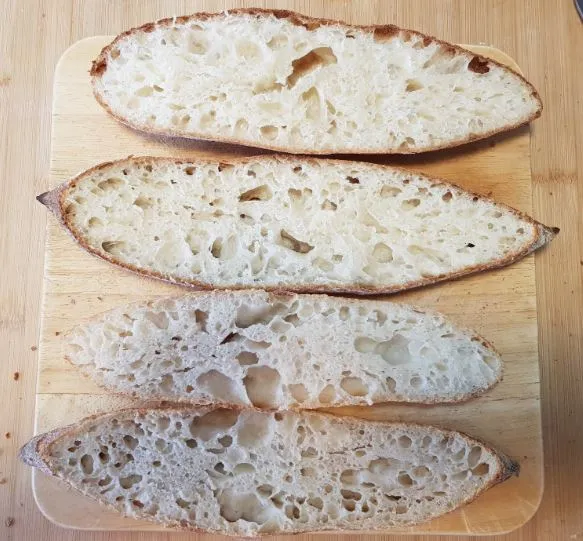
Image
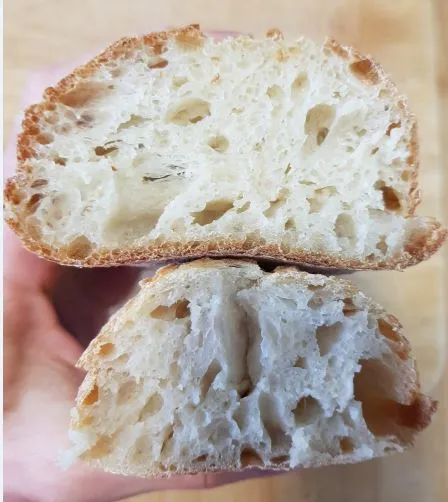
That just about wraps up a fun and tasty experiment - 12 (demi) baguettes in 10 days with 4 different doughs and a total of 5 different retard timings.
Tomorrow is a new day and a new bake awaits . . . bánh mì! (Kind of a lateral move from a demi baguette, I know, but I asked my partner what I should make and the response was "rolls". " For a sandwich". Yes dear, I understand the concept of a bread roll . . .